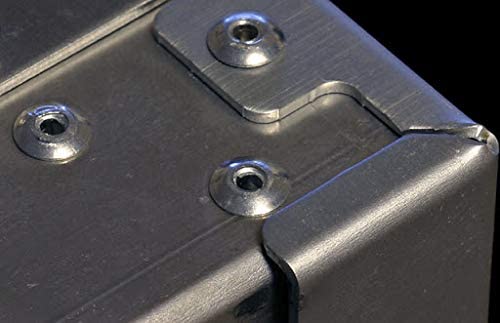What is Pop Rivets and How Does It Work? – Blind rivets and pop rivets both fall under the category of rivets. They are utilized in situations where there is little to no access to the backside (also known as the “blind side”) of the components that need to be linked.
On Linquip website, among the many options available to you, you will find all the information you need to know about Rivets, as well as information regarding this marketplace. You can count on Linquip to provide you with as much general and reliable information about this topic, whether you’re a professional or a customer looking for a proper company. We recommend you review a list of all Rivets for Sale available in Linquip.
We would be delighted to provide you with more information on how we can help you generate revenue within your industry. Don’t hesitate to contact us if you have any questions! With Linquip’s Solutions for Each Company Level, you will be able to upgrade the capabilities of your organization in order to gain a competitive edge by taking advantage of a wide range of options to enhance your organization’s performance. If you are looking for the simplest or the most sophisticated marketing and advertising package for your business, we can help you ensure that your company gets as many customers as possible to grow business.
What Is A POP Rivet?
Blind rivets and pop rivets both fall under the category of rivets. They are utilized in situations when access to the back (blindside) of the pieces that need to be linked is either restricted or nonexistent.
Pop rivets are a specific kind of blind rivet made to be inserted from just one side of a joint, making them very useful for fabrication and assembly tasks when access to both sides of the workpiece is restricted.
Pop rivets have a very straightforward construction that consists of a mandrel that fits through the shank of the rivet and a shank that is placed into a pre-drilled hole. A blind riveting tool is used to draw out the mandrel, compressing the shank on the workpiece’s blind side and bringing the material together to attach the rivet.
The mandrel is broken off at a pre-determined nick for a clean finish once the joint is finished. Because of the noise made when the mandrel separates from the rivet, these fasteners are known as “pop rivets.”
The force needed to attach a rivet varies on its size and intended use although installation is often performed with a single, gentle tugging action. A manual pop rivet tool can be used for quick repairs or for adding a few rivets.
Use a pneumatic or electric pop riveting tool with additional pulling power for demanding applications like manufacturing or construction.

Working Principle of POP Rivet
Pop rivets have two components. The rivet body, often known as the shell or hat, is the first component, while the mandrel is the second (also called the stem).
A hole is initially drilled through the pieces to be linked in cases when access to either side of a component is restricted. The pop rivet is then brought into contact with the pieces after being introduced through the drilled hole.
In order for the rivet to expand and retain the components to be attached, a rivet gun must be used to draw the mandrel into the rivet body. The mandrel snaps into position after it has been grasped, holding the rivet firmly in place. There is a localized link as a result.
Parts of a POP Rivet
Rivet pin: The rivet pin, which will pass through the pieces of material being linked together, is the rivet’s primary body.
Rivet head: To prevent the rivet from slipping out of the material, the head will sit on the exterior of the material.
Rivet mandrel: When it is secured, the mandrel is inserted into the rivet gun through a slot. The mandrel is partially pulled through the rivet’s pin (or “body”) by the rivet gun, which subsequently deforms the pin to create a second head.
Rivet mandrel head: The mandrel head extends the rivet body before disappearing within the rivet to form a second head that fastens and secures the components that are being connected.
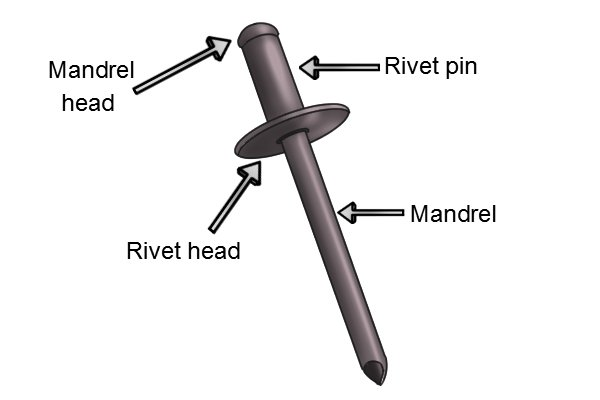
Different Types of POP Rivets
The hollow cylindrical pin (body) of a blind rivet, also known as a pop rivet, is joined to the head. At the other end of the body from the rivet head, a mandrel—a long, thin pin with a head—passes through the body’s recess and acts as a stop.
There are several body and head types for blind rivets. They are constructed using various materials.
Standard Blind Rivets
Metal-to-metal connections are frequently made using common blind rivets. They have basic bodies and heads with domes. The rivet body will expand at its “blind” end and form a second head that may be used to permanently bind the materials together if you partially draw the mandrel through the rivet.
Numerous sectors, including those in the automotive, building, metallurgy, electrical appliance, container, furniture, air conditioning, and heating, employ standard rivets.
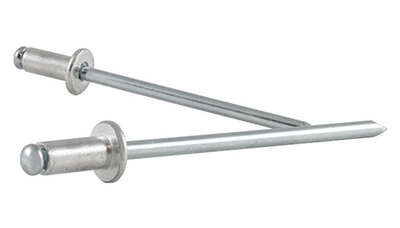
Sealed Blind Rivets
This particular style of the blind rivet has a sealed end. Unlike other types of blind rivets used in the sealed body, the mandrel head does not stick out from the end of the rivet. Metal-to-metal connections are made with sealed rivets, which prevent liquids from penetrating or leaking.
While the head of the rivet is sealed, the mandrel’s head rests inside the rivet’s body. As a result, liquid cannot enter or leave the component. They are appropriate for usage in the metal, building, and automotive sectors. Additionally, they may be found in containers, furniture, air conditioning, and heating systems, as well as electrical gadgets.
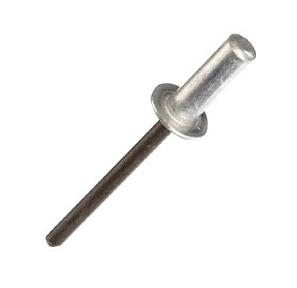
Grooved Blind Rivets
This type of rivet has good holding strength when fixing softer materials like plastic and wood due to the grooves surrounding its body. Metal to wood and metal to construction materials, including cement, brick, and wood can both be fastened with grooved rivets.
The material is held together almost like a screw by the grooves on the rivet body, which is embedded in the substance. It is not necessary for the hole it enters to penetrate straight through the surface.
Instead of producing a new head on the opposite side of the material, the tail of a grooved rivet will extend within the material as the mandrel is removed. The rivet’s head at the opposite end grabs the object that is attached to the material, but the grasp is frictional rather than mechanical.
Construction, metalworking, furniture production, electrical equipment, and injection molded items are the greatest applications for grooved rivets.
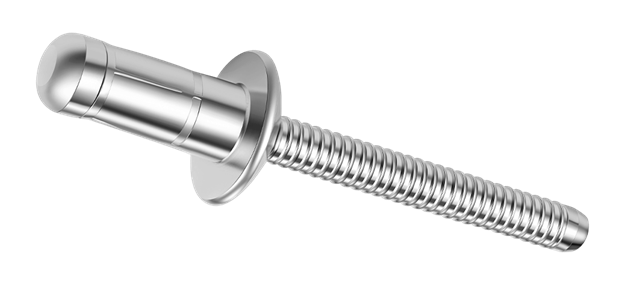
Peeled Blind Rivets
Peeled rivets increase the diameter of the locking head, giving it a larger bearing surface (underside of the head). The body enlarges as the mandrel is dragged through, leaving the head in the form of a flower with four petals. The optimum application for this kind of rivet is joining metal to softer materials.
A head is formed by folding the sides (petals) of the rivet over, which secures the materials together. Peeled rivets are perfect for use in the construction sector (plasterboard, coatings, and insulation), the automobile industry, and on trailers, plastic parts, electrical appliances, and upholstery (padded covering on furniture).
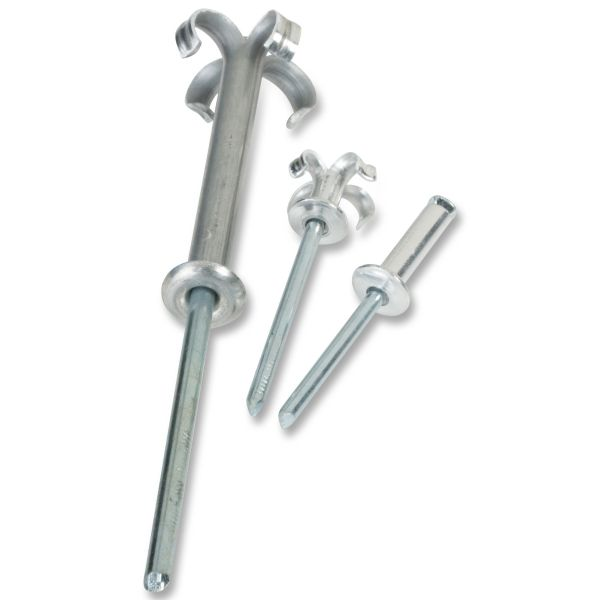
Multi-Grip Blind Rivets
Similar to regular rivets, multi-grip rivets also include indents on the rivet body. When the mandrel is dragged into the body, the indents enlarge and offer several grips. These rivets are used to join plastic to plastic and metal to metal.
As the mandrel is dragged through, the various grips on the rivet’s body are pressed up against the material being fastened. The automotive, building, and metal sectors, as well as the production of ladders, furniture, electrical appliances, electronics, and air conditioning and heating, may all benefit from the usage of multi-grip rivets.
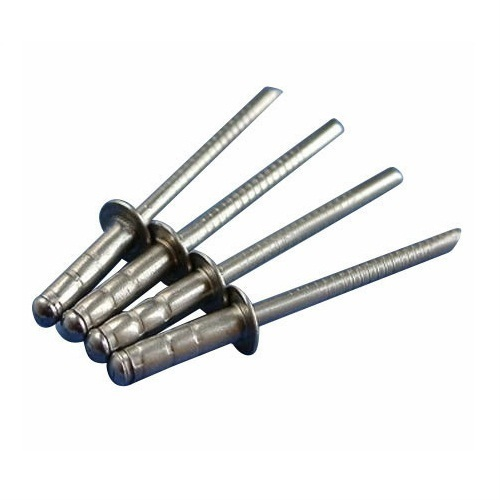
Soft Set Blind Rivets
Standard rivets and soft rivets are interchangeable. On the other hand, the body and mandrel are made of softer metal, usually an aluminum alloy. The mandrel delivers the proper amount of pressure to secure fragile materials without causing harm since it breaks off with significantly less force than other types of rivets.
These rivets may be used to secure soft materials with little resistance to metal or plastic, as well as to fasten metal to plastic, wood, fiberglass, and plastic to plastic. Soft rivets can be utilized in building, furniture, packing, plastic parts, and containers.
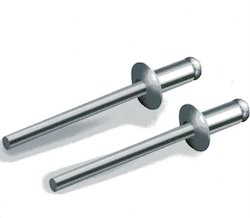
Dome Head Blind Rivets
Except for highly smooth and brittle materials like plastic, the dome head’s ample bearing surface allows it to be used to secure a range of materials.
This is so that softer materials won’t be damaged, as this style of the head puts greater pressure closer to the drilled hole. The contact between two materials is known as the bearing surface. In this instance, the portion of the rivet that makes contact with the material being secured is the region under its head.
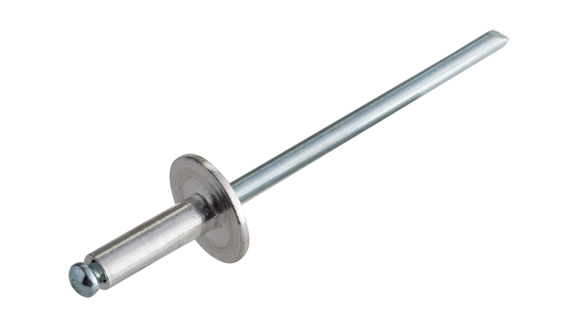
Choosing the Right POP Rivet Tool
Naturally, the pneumatic POP rivet tool you select needs to be of the highest caliber, made by a recognized company, and simple to use. Beyond those fundamentals, you should consider these six aspects when choosing a riveter:
1. Size
You must consider the size of the riveting tool itself in addition to the size of the rivets you will be using and the necessary stroke. Everything relies on the purpose for which the instrument is employed.
2. Appropriateness
Whichever tool you use, you must also take into account the kind and substance of the rivets in addition to the size. Requirements for tools and nose assembly are unique for structural or “high break load” rivets. You don’t want to learn too late that the riveter you purchased isn’t capable of handling a specific type of rivet.
3. Power
Another significant consideration when choosing a tool is the amount of traction power needed for the task. The installation of rivets might go wrong if there is insufficient force. Having too much traction power might also be problematic. You might use a device that enables you to quickly change the force as required. For instance, the most recent cordless tools from Huck provide a special way to tune in the precise pulling power needed.
4. Optimal Design
If you just sometimes use the instrument, ergonomics won’t be a factor, but if you use it frequently, you should take the user’s degree of long-term comfort into account. In addition to having a higher risk of harm, drowsy users may rivet poorly, lowering the quality of the final product.
5. The Workstation Setting
When selecting a tool, it is important to keep in mind that small and constrained workspaces might hinder riveting skills. A pneumatic riveter with a collecting receptacle can be a smart choice if the accumulation of used mandrels on the floor is intolerable.
6. Riveting Needs
Finally, consider the requirement for the frequency of usage of a pneumatic POP rivet tool. In the same way that an occasional-use model won’t satisfy heavy-duty needs, a pricey tool won’t make sense if you don’t place rivets frequently.
Download What is POP Rivets and How Does It Work? PDF
You can download the PDF format of this post from here.
Buy Equipment or Ask for a Service
By using Linquip RFQ Service, you can expect to receive quotations from various suppliers across multiple industries and regions.
Click Here to Request a Quotation From Suppliers and Service Providers
Read More on Linquip
- 13 Types of Rivets + Applications & Working Principle
- 7 Types of Solder + Working Principle & PDF
- What Is The Difference Between A Blind Rivet And A Pop Rivet?
- The 10 Best Rivet Tool in 2023
- The 10 Best Angle Grinders of 2022
- The 10 Best Welding Machines in 2022 + Buying Guide
- 16 Types of Scaffolding + Components & PDF
- 28 Types of Clamps: A Complete Guide
- The 10 Best Electric Lawnmowers in 2022
- The 6 Best Leaf Blowers of 2022 + Buying Guide & PDF
- The 10 Best Welding Machines in 2022 + Buying Guide
- 9 Types of Pop Rivet + Working Principle (Clear Guide)
- What is Pop Rivets and How Does It Work? (A Comprehensive Guide)
- 9 Types of Pop Rivet + Working Principle (Clear Guide)
- 18 Types of Machining Vises (Clear Guide)
- 8 Types of O-Ring + Applications (Clear Guide)
- The 10 Best Snow Blowers of 2022 + Buying Guide & PDF
- The 10 Best Electric Pressure/Power Washers in 2022
- The 10 Best Torque Wrenches For 2022 + PDF & Buying Guide
- The 8 Best Attic Ladders in 2022 + Buying Guide & PDF
- The 10 Best Electric Space Heater in 2022 + Buying Guide
- 4 Types of Solid Rivets + Working Principle
- What Is Flush Rivet And How Does It Work? (A Comprehensive Guide)
- How Springs Are Made? 5 Fundamental Steps (Clear Guide)

